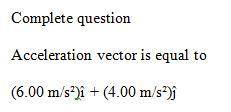
Physics, 25.02.2020 05:07 cassandrabeliles
At t1 = 1.00 s, the acceleration of a particle moving at constant speed in counterclockwise circular motion is At t2 = 2.00 s (less than one period later), the acceleration is The period is more than 1.00 s. What is the radius of the circle?

Answers: 3


Another question on Physics

Physics, 22.06.2019 08:00
You have a pick-up truck that weighed 4,000 pounds when it was new. you are modifying it to increase its ground clearance. when you are finished
Answers: 1

Physics, 22.06.2019 12:30
If you place a magnet under a clear dish, and sprinkle iron fillings over it, above what part of the magnet will most of the fillings gather
Answers: 2

Physics, 22.06.2019 18:30
Apropagating wave in space with electric and magnetic components. these components oscillate at right angles to each other. it may travel in a vacuum. determine the term.
Answers: 2

Physics, 22.06.2019 20:30
This is a form of winter precipitation. it is frozen precipitation falling as ice pellets. snowflakes melt into raindrops as they pass through a thin layer of warmer air. the raindrops then refreeze into particles of ice when they fall into a layer of sub-freezing air near the surface of the earth. this precipitation is called a) hail. b) rain. c) sleet. d) snow.
Answers: 1
You know the right answer?
At t1 = 1.00 s, the acceleration of a particle moving at constant speed in counterclockwise circular...
Questions




Mathematics, 12.11.2020 04:10


English, 12.11.2020 04:10


Computers and Technology, 12.11.2020 04:10


Arts, 12.11.2020 04:10

Mathematics, 12.11.2020 04:10



Spanish, 12.11.2020 04:10



Mathematics, 12.11.2020 04:10

History, 12.11.2020 04:10

Chemistry, 12.11.2020 04:10

Biology, 12.11.2020 04:10

 meters
meters
 are time range for two acceleration vectors and angle between two acceleration vector respectively and r is the radius of the circle
are time range for two acceleration vectors and angle between two acceleration vector respectively and r is the radius of the circle






